This paper studies the relationship between Economic Growth and Innovation and Entrepreneurship in the Republic of Belarus. The empirical analysis conducted in this study shows that the Innovation system and the Entrepreneurial system have a significant effect on the Gross Domestic Product growth. However, the analysis also indicated that the effects are insignificant when analyzing their effects on the Belarusian Economy. This can be seen as empirical evidence that the Belarusian Economy is not developing at the fastest possible pace. In this context, it is particularly important to study the effect of Innovation and Entrepreneurship on national Economic Growth. There is a necessity to identify the underlying problems that negatively affect the Belarusian Economy and its growth rate. In solving these negative factors there is a large potential to initiate not only for quantitative growth, but also for structural change that will ensure the future stability of the national Economy.
Keywords : the Republic of Belarus, Innovation; Entrepreneurship, Economic Growth.
Research background and significance of the study
The systemic integration of national economies, international concentration of capital, and integration of world markets and globalization of economic activities of companies characterize the modern development of the world community. Its most important factors are scientific and technical progress and intellectualization of the main factors of production. The economic and technological dominance of the United States, Japan, and the European Commonwealth countries is based on knowledge-intensive and high-tech industries and provides these countries with political dominance in the world.
Realizing the importance and exceptional importance of the innovation sphere, the governments of these States have moved to an aggressive innovation policy through state support and special state programs. This will make a powerful technological leap for companies based in these countries, and will ensure an even greater gap in all macroeconomic indicators in these countries compared to the rest.
Literature review
Despite the variety of research interpretations of the problem of innovation management, the issues related to the integration of an innovation management system in the process of forming the goals and development strategies of Belarusian companies operating in a competitive market environment remain not fully studied. However, at the microeconomic level, the analysis of innovations as a separate branch of economic science began to develop much later. The development of innovation assessment abroad took place in the framework of evaluating the effectiveness of investment and financial management of enterprises, and are associated with the names of Choi K. (1983), Mansfield E. (1982), Santo B. (1990), Twiss B. (1999), Freeman C. (1982), Schumpeter J (1934)., and others.
A new branch of the literature, which emerged under the brand name ‘national innovation systems’ (NIS) — was mainly developed by three scholars; Christopher Freeman (1987), Bengt-Åke Lundvall (1992) and Richard Nelson (1993). However, as we shall see, the contributions by Lundvall were in several ways particularly important in this respect. Not necessarily because he was the first to use the term but because his work was embedded in a broader theory of the relationship between various social factors, such as shared culture, values and institutions, on the one hand, and learning, innovation and competitiveness on the other hand. The central focus of this approach, which became very influential, was on interactive learning, not only in a few selected industries but economy-wide, as a driving force of long run economic development.
Jan Fagerberg’s (1987) tests the technology gap approach to development and growth. The main findings of Jan Fagerberg’s paper are the following: (1) there exists a close correlation between the level of economic development measured as GDP per capita, and the level of technological development, measured through R&D or patent statistics. (2) Technology gap models of economic growth explain rather well the differences in growth between the industrialized countries as a whole in the post-war period. (3) The models are less well suited in explaining the (much smaller) differences in growth between developed countries, especially the small and medium-sized ones, most of which are on approximately the same level of development.
The Belarussian Innovation system
In recent years, there have been certain changes in the relations between the main participants of the national innovation systems of foreign countries. The role of the state in stimulating innovation activity and in forming the necessary institutional structures has increased. The role of universities and budget-funded research organizations in the innovation activities of companies has increased, while reducing the size and number of research units of firms. The link between science and production has become closer. New innovative firms and high-tech small and medium-sized enterprises received more government support and incentives to organize their activities.
The concept of the national innovation system of the Republic of Belarus was developed and approved by the Government in 2006, and the State Program of Innovative Development (SPID) is defined in it as the main program document for the implementation of the main directions of the state innovation policy. The country has formed and implemented the GPIR for 2007–2010; 2011–2015 and for 2016–2020, which includes a number of projects and goals to modernize the Belarusian economy and strengthen its competitiveness at the international level. This program contains goals for the further development of NIS and innovation support institutions, modernization of innovation infrastructure, and promotion of innovative entrepreneurship. At the same time, the program does not specify the policy and tools for financing its implementation. It should be noted that at present Belarus, on the one hand, has a well-developed system of state institutions that form the basis of the NIS and support innovation activities. On the other hand, the complex structure of state bodies with broad powers in the implementation of science, technology and innovation policies makes it difficult to manage innovation. The decision-making process in Belarus is characterized by a top-down administrative approach and is usually preceded by a lengthy and complex preparatory bureaucratic stage with the participation of interested institutions.
The low level of innovative activity is also reflected in the low knowledge intensity of GDP. The GDP science intensity indicator is below the threshold value for ensuring scientific and technological security (1 %) and it has a negative trend and remains at the level of 0.5 % of GDP in recent years. Such a value of the indicator is not able to ensure the reproduction of scientific and technical potential. World experience shows that if the value of the science intensity of GDP is below 0.4 %, science can only perform a socio-cultural function in the state.
Belarus' low innovation indicators are in spite of the significant scientific potential in the country, 80 % of which is concentrated in the National Academy of Sciences and research and development organizations of the Ministries of Industry, Education and Health. Basic research is conducted mainly at the National Academy of Sciences, while there is a gradual shift towards more applied projects. The research potential is mainly focused on servicing traditional sectors of the economy, represented by a small number of enterprises. Recently, the effectiveness of the scientific staff as an important part of the scientific potential has been negatively affected by the age structure of researchers and the «brain drain». The indicators of the country's innovation activity do not reflect the high educational potential, which, however, does not fully meet the needs of the national labor market: the practical component of education is insufficient; there is a shortage of specialists in the innovation field.
Empirical Models
For the purpose of this study, the Fixed Effects model was chosen based on its effectiveness in accounting for the unobservable country specific effects that would have influenced the regression using OLS methods.

Where:







Where:







The time demeaned regression model (2) does not contain the country specific effect and we are left with a model that can accurately predict the coefficients of the selected variables.
This study analysis the potential for GDP Growth in the Belarusian Economy, therefore it is important to specify variables that will represent the macroeconomic fields of interest. Extensive research exists on GDP Growth based is a function of Capital and Labor. Because of this, these two macroeconomic categories have been selected as the base for my regression model (3).
In macroeconomic analysis, it is assumed that the level of organizational and technical knowledge is fixed, and all material factors are combined into one factor — capital. Therefore, the production function includes two factors on which output depends: labor and capital.

Where: Q — the production quantity; L — Labor; C — Capital
Consequently, the production function characterizes the technical relationship between the amount of resources used and the maximum volume of output per unit of time.
The production function describes a set of technologically efficient production methods, each of which is characterized by a certain combination of resources necessary to obtain a unit of production at a given level of technology. As a technological ratio, the production function can only be determined empirically by changing the actual indicators.
This paper anlyzes the influence of Innovation and Entrepreneurship on Belarusian Economic Growth, so it is necessary to variables that can be assumed as proxies for such abstract economic categories. For this purpose total Research and Development Expenditure in US dollars has been selected as a representation of the Innovative system and the total number of Paten Applications has been selected as the representation of the level of innovative thought and intellectual freedom, which can be seen as a reflection of the general entrepreneurial level of the country.
As we can see from figure 1, 2 and 3 using the variables in absolute numbers can impose a certain level of skewedness to the regression model and affect the overall outcome of the empirical analysis. For this reason, all five variables have been transformed into the form of their natural logarithms. Although the distribution of the natural logarithms is not perfect, this has led to a more normal distribution throughout all of the variables.
For the analysis, 31 countries have been selected and data for 9 years (2003–2011) has been collected. The countries were chosen on the principle of randomness, for this reason countries from different regions were chosen.
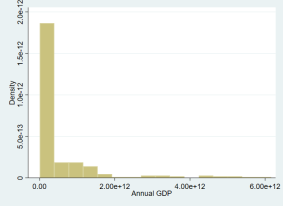
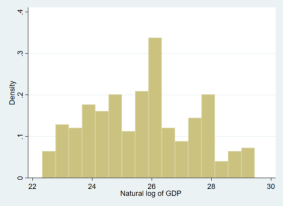
Fig. 1. Annual GDP and Natural Logarithm of GDP
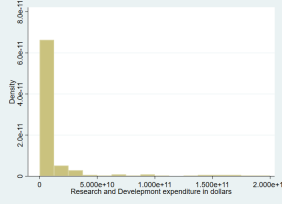
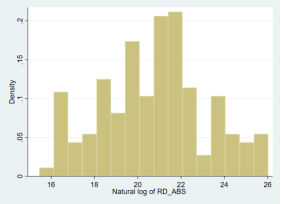
Fig. 2. Research and Development in Dollars and Natural Logarithm of Research and Development in Dollars

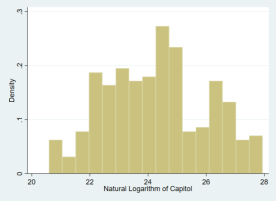
Fig. 3. Gross Capital Formation in Dollars and Natural Logarithm of Gross Capital Formation
For both models analyzed in this paper, the null hypothesis and the alternative hypothesis can be stated as following:

The null hypothesis is that the selected variables are statistically insignificant by themselves and jointly in the model. The alternative hypothesis states that the variables are significant at the 90 % level and higher and that they are jointly significant as well.
The model proposed in this paper uses the Production Function as its basis and then further adds variables that can be seen as representative of the Innovative level of the analysed Economies.

Where: ln_gdp — the Natural Logarithm of Gross Domestic Product, ln_capital — the Natural Logarithm of Gross Capital Formation; ln_labor — the Natural Logarithm of Total Labor Force Participation.

Where: ln_gdp — the Natural Logarithm of Gross Domestic Product; ln_capital — the Natural Logarithm of Gross Capital Formation; ln_labor — the Natural Logarithm of Total Labor Force Participation; ln_rd — the Natural Logarithm of Research and Development Expenditure; Patenting — the total number of Patenting Applications.
Model 1 is the base model of the Production Function. This model explains 83.86 % of the difference in the dependent variable based on the independent variable. Model 2 has the additional variable that represent the Innovative and Entrepreneurial aspects of the GDP Growth. The second model has a

The variables of ln_capital and ln_labor are both significant at the 99,9 % level in Model 1 and are significant at the 99,9 % and 99 % respectively in Model 2. Ln_rd is significant at the 99,9 % level and patenting is insignificant. Both models are jointly significant as F is greater than P by 0.0000, which indicates statistical significance for both models.
Table 1
Regression results for model on 31 countries (2003–2011)
|
Variables |
Model 1 |
Model 2 |
|
Ln _ rd |
0.3961 *** (0.023) |
|
|
Patenting |
-1.24e6 (7.70e7) |
|
|
Ln _ capital |
0.6861 *** (0.0252) |
0.3888 *** (0.0243) |
|
Ln _ labor |
0.6717 *** (0.1616) |
0.5689 *** (0.1091) |
|
_cons |
-1.4032 (2.2306) |
-0.7781 (1.5029) |
|
R2 within |
0.8386 |
0.9275 |
|
R2 between |
0.9097 |
0.9409 |
|
R2 overall |
0.9065 |
0.9385 |
|
P>F |
0.0000 |
0.0000 |
|
Corr (u_i, X) |
-0.6256 |
-0.8164 |
|
Sigma_u |
0.6743 |
0.7448 |
|
Sigma_e |
0.1282 |
0.0863 |
|
rho |
0.9651 |
0.9867 |
|
N of obs |
279 |
279 |
*** — p > 0.01; ** — p > 0.05; * — p > 0.1;
To further analyze the Republic of Belarus both models have been applied to a larger period to guarantee a higher degrees of freedom and more accuracy to the regressions. Using the Production Function model the statistical significance of the regressors is similar to the results of the analysis of 31 countries. However, after adding the variables for Innovation and Entrepreneurship we see that the significance of ln_capital and ln_labor has become lower and that the added variables (ln_rd only 90 % significant; patenting is insignificant) are insignificant.
Table 2
Regression results for the Republic of Belarus (2000–2013)
|
Variables |
Model |
|
Ln _ rd |
0.1952* (0.0971) |
|
Patenting |
-0.0001 (0.0001) |
|
Ln _ capital |
0.4728*** (0.114) |
|
Ln _ labor |
7.6568** (2.5794) |
|
_cons |
-109.2147 (38.8043) |
|
R2 |
0.9978 |
|
Adj R2 |
0.9969 |
|
P>F |
0.0000 |
|
N of obs |
14 |
*** — p > 0.01; ** — p > 0.05; * — p > 0.1;
These results show that although there is a definite correlation between Gross Domestic Product Growth and Innovation in many countries there seems to be little to none in the Republic of Belarus. These results can be seen as empirical proof of the ineffectiveness of the Innovation and Entrepreneurial systems of the Republic of Belarus, therefore indicating to a necessity for reformation and positive change.
Solutions for Economic Growth in Belarus
It is necessary to reduce the amount of administrative interference in the economy, especially artificial restrictions on economic activity and in general lowering the quantity of government owned enterprises. Transitioning to the principles of corporate governance applied in the world practice, especially in the framework of the activities of transnational corporations (TNCs), without the participation of which the process of integration into the world economy is impossible.
Developing a state program for the commercialization and privatization of public utilities and services exclusively in the form of technical assistance will ensure the facilitation of business activity growth. Consistent integration of domestic enterprises into the production cycles of international concerns using competitive advantages (level of production costs, availability of qualified personnel) — especially in industries that contain development potential (light and textile industry, petrochemical industry, construction, services and infrastructure development).
An important problem is to improve the efficiency of the personnel component of scientific and technical potential. To develop this personnel component a policy for creating conditions for working in science by equipping it with modern means of labor-devices, equipment, materials, and information and communication technologies must be implemented by the government. As well a policy for a significant increase in the level of remuneration for researchers and developers in relation to other categories of specialists must be developed. It is possible to increase the national scientific and innovative potential through the implementation of state support programs for young specialists and scientists, assistance in the development of high-tech industries, national high-tech parks, patent and licensing activities. Additional incentives for the revival of patent activity should be included in programs to support the development of small and medium-sized businesses (for example, in the form of announcing competitions with the provision of scholarships/grants for employees, organizing international cooperation events to exchange experience and know-how, etc.). Also the creation of financial institutions and specialized agencies (including state insurance agencies) that interact with international financial institutions and support the import of technologies and equipment will support the innovative potential of scientific enterprises.
Providing support to greenfield investment projects (possibly by simplifying the registration procedure, tax treatment, etc.). Over the past two years, only 26 such projects have been implemented in the republic, which is 0.1 % of all greenfield projects implemented in the world during this period. According to this indicator, Belarus is significantly ahead of Russia — by 38.5 times, the EU as a whole has implemented 276.4 times more projects, and Ukraine is ahead of Belarus by 6.9 times. At the same time, the volume of greenfield projects implemented in the national economy is an indicator of investment reliability and the presence of a favorable investment climate in the state, which ultimately contributes to attracting investment capital.
Conclusion
The Government of the Republic of Belarus is aware of the need to smooth out the difficulties faced by entrepreneurs, and in this regard, adopts State programs to support small and medium-sized businesses in the Republic of Belarus, aimed at actively stimulating the development of the business of entrepreneurs, solving the problems faced by entrepreneurs in the course of their activities. They define the further development of all the main types of state support for small and medium-sized businesses in the country. Among them: financial, property and information support of business entities, assistance to the unemployed in the organization of entrepreneurial activities, involvement in business activities of socially vulnerable groups of population through seminars, round tables with participation of heads of small and medium enterprises of the Republic, and to support the development of start-up movement in Belarus with the subsequent deployment of a network of start-up schools and others.
The transition to a post-industrial society involves the transformation of scientific and technical policy from a set of measures for the management of science and technology as a separate object into one of the core elements of the entire system of state regulation. With the intensification of innovation processes, the influence of the selected guidelines in the scientific and technical sphere on the trajectory of socio-economic development in general will increase. In this regard, it is necessary to link the scientific and technical strategy with other components of state regulation — industrial, social, information and environmental policies.
In order for this mechanism to work, first of all, it is necessary to organize training of specialists — both officials, heads of enterprises, and managers of companies. In higher education institutions, preferably in the last years of study, enter the appropriate course of lectures with the invitation of leading specialized specialists. Organize a series of foreign internships in countries with experience in public — private partnership implementation.
It is also necessary to adopt a state program for the development of advanced technologies based on the use of public-private partnership and to minimize administrative procedures for various types of inspections, which cause caution in organizations of non-state ownership.
In this context, the most important component is the adoption of the law on public-private partnership, including innovation. It seems that such an approach to the creation of a public-private partnership mechanism will help reverse the negative trend in the field of innovative development and will enable Belarus to take a worthy place in the club of developed countries in the next 5–10 years.
References:
- Decree of the President of the Republic of Belarus «on certain measures to streamline payments in the Republic of Belarus» dated 22.02.2000 No. 82 (national register of legal acts of the Republic of Belarus. -2000. — No. 23. — St. 1/1035)
- Resolution of the Council of Ministers of the Republic of Belarus «on providing financial support to small businesses» dated 24.07.1998 No. 1178 (Collection of decrees, decrees of the President and resolutions of the Government of the Republic of Belarus. -1998. — No. 21. — St. 571)
- The concept of the state program of innovative development of the Republic of Belarus for 2011–2015/ / national legal Internet portal of the Republic of Belarus. [Electronic resource]. — http://pravo.by/main.aspx?guid=3871&p0=C21100669&p2={NRPA}#Zag_utv_1
- International Monetary Fund Database. [Electronic resource]. — https://www.imf.org/en/Data
- The Belarusian State Statistical Committee. [Electronic resource]. — https://www.belstat.gov.by
- The United Nations Country Indicators Statistics Database. [Electronic resource]. — http://data.un.org
- The World Bank Country Indicators Database. [Electronic resource]. — https://data.worldbank.org/country
- Choi, K. (1983) Theories of Comparative Economic Growth. Iowa State University Press, Ames.
- Fagerberg J. (1987) A Technology Gap Approach to Why Growth Rates Differ, Article in Research Policy
- Freeman, C 1995. The national system of innovation ‘in historical perspective’. Cambridge Journal of Economics, 19, 5–24.
- Freeman, C 2004. Technological infrastructure and international competitiveness. Industrial and Corporate Change, 13(3), 551–569.
- Lundvall, B-Å 1988. Innovation as an interactive process: from user-producer interaction to national systems of innovation. In Technical Change and Economic Theory, eds G Dosi, C Freeman, R Nelson, G Silverberg and L Soete. London: Pinter.
- Lundvall, B-Å ed. 1992. National Systems of Innovation: Towards a Theory of Innovation and Interactive Learning. London: Pinter.
- Mansfield, E., A. Romeo, M. Schwartz, D. Teece, S. Wagner and P. Brach (1982) Technology Transfer, Productivity and Economic Policy. Norton, New York
- Santo B. Innovation as a means of economic development: TRANS. Weng. — Moscow: Progress, 1990, p. 296
- Schumpeter, J. (1934) The Theory of Economic Development, Harvard University Press, Cambridge MA.
- Twiss B. Management of scientific and technical innovations: Per. with English.- Moscow: Economy, 1989, p. 271.







